
Ficus Species & Hurricane Horticulture
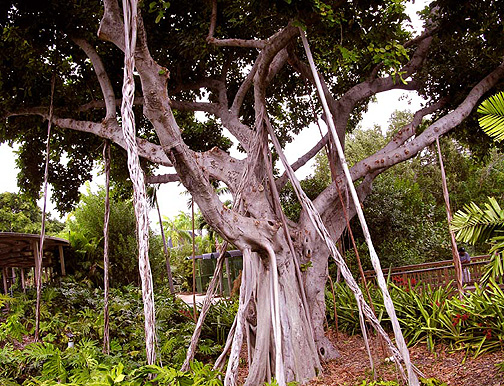
Reprinted from:
City Trees: Journal of the Society of Municipal Arborists
www.urban-forestry.com
March 2007
Ficus trees are among the most distinctive trees in tropical and subtropical urban landscapes. These trees can reach stately proportions with immense canopies and very tropical-looking aerial roots that in time can form large trunks. The very characteristics that make Ficus great landscape trees can also make them the wrong tree to plant in the wrong place. A fast rate of growth, along with a heavy dense canopy and shallow root system can make ficus trees the bane of utilities and foundations. Often they are planted improperly or in the wrong location resulting in damage when the tree succumbs to high winds or the branches and roots grow into nearby utilities.
Here in South Florida many species of exotic Ficus are grown, from the wall climbing Ficus repens, to trees that can reach giant proportions i.e. the Banyan trees, F. altissima and F. benghalensis. Some of the other Ficus species commonly found here are F. elastica, F. benjamina, F. religiosa and F. microcarpa. There are two native ficus taxa found in our area; F. aurea and F. citrifolia.
From a horticultural viewpoint, the value of ficus trees in the landscape is incalculable. Stand underneath one of these trees on a hot day and experience the shade they provide and the cooler temperatures found underneath their canopy. For tropical urban areas that act as heat sinks, this is a perfect tree.
In our area, no fertilizer is ever needed to encourage the growth of these ficus and they have few insect pests. How many other species of trees used in urban plantings don’t require soil amendments, fertilizer, or insecticide applications? I have never had to fertilize or spray a Ficus tree.
However, if the trees are not properly planted and pruned, the massive canopies are very vulnerable to high winds. The hurricanes that South Florida experienced in 2005 proved that point. For us, Hurricane Katrina was only a category 1 storm, and Hurricane Wilma was only a category 2 storm, but hundreds of trees--many of them Ficus species--succumbed to windthrow, resulting in a tremendous amount of damage.
In 1992, as the director of horticulture at the original Parrot Jungle (a privately owned zoological theme park) I experienced Hurricane Andrew, a category 5 storm, in 1992 first hand while riding out the storm at the park. This 20 acre facility had dozens of mature Ficus trees, only three ficus trees succumbed to windthrow!
There was a tremendous amount of damage to our trees overall, but the Ficus recovered well. This I attribute to two things: a regular pruning program in which all ficus were pruned every two to three years, and digging large holes for the trees when they were planted.
One very large Banyan Tree, a F. altissima had much branch damage, but no damage to the trunks or established aerial roots that had become trunks. This tree is still alive due to these aerial roots that had been allowed to grow originally to give the tree a more tropical look but then functioned as stabilizers for structural support of the tree in the high winds. These aerial roots, now trunks, had all been artificially induced 25 years previously!
When Parrot Jungle relocated to the City of Miami as Parrot Jungle Island, initial grading and landscaping of the 18 acre site began 2000, with the park opening in 2003. After initial site contouring and grading only one tree had been left on the site, a mature F. benghalensis (all other trees had been moved off to be eventually relocated back onto the site as construction allowed). This tree had no aerial roots so I began to artificially induce them.
Not all ficus species readily produce aerial roots, but in the case of F. benghalensis and F. altissima, aerial roots grow quite well and rapidly. In the instance of the mature F. benghalensis, I used an all-terrain 40’ (12-m) aerial lift to provide access to the high lateral branches and to be able to work underneath them. Some of these branches had a girth that I could not put my arms around and I would not have had access to the underside of the branch with a ladder.
Inducing aerial roots in Ficus is similar to creating an air-layer on a branch: the bark, the cambium, and the phloem layer is removed from a section of the branch, and the xylem is left intact. However, unlike an air-layer, the branch is not girdled. I have found that cutting out a square section underneath the branch that is almost the width of that branch and five to six inches long, will promote aerial root growth. If the cut is too small, that section will heal over; if the cut is too large roots will not grow.
I prefer to work with a hammer and sharp chisel and am mindful of the sap that comes out; it is very sticky and can be a bit caustic. After the cut is complete and cleaned out, I take rough burlap and fold it until it is several inches thick and put it against the finished cut making sure the burlap overlaps the cut on all sides by several inches. I affix the burlap to the branch with heavy duty zip-ties.
Depending on the time of year and the health of the tree, aerial roots will appear through the burlap in a couple of months. I then hang a burlap sock under the original cut that completely wraps the growing aerial roots and hangs down several feet. This hanging sock definitely encourages the roots to grow faster. Ideally the roots are watered several days a week.
When aerial roots grow out of a section on the branch they often do so in dozens. As they grow in length and especially once they reach the ground, the individual roots coalesce and form a single trunk.
For other species of ficus that grow aerial roots--e.g. F. benjamina and F. microcarpa, I use a different method to initially support the tree against wind throw, and then grow the aerial roots. Since aerial root growth on these trees is much slower and smaller in scale than the Banyan trees, I place recycled telephone poles around the tree.
They are dug into the ground and placed in a vertical position underneath a large lateral branch so the top of the pole sets snugly against the underside of the branch. The poles are set as far away as possible from the main trunk so they will support the tree in compression when the wind blows from the other side of the tree. Aerial roots will start to grow from the supported branch and when the roots are long enough, I wrap them against the telephone pole with burlap. As before, the burlap enhances the rate of growth by providing moisture for the roots.
I started using this method to support ficus trees that had fallen over or tilted in Hurricane Katrina at Parrot Jungle Island. None of the ficus trees supported in this manner moved during Hurricane Wilma. Now all of the smaller Ficus species at the park are supported by recycled telephone poles, and many of the poles already have aerial roots that have grown down the length of them into the ground.
Ficus are excellent landscape trees both for their ornamental value and the fact that they require so little care, other than regular pruning. Planting them properly and utilizing their aerial roots for stability will solve many of the windthrow issues in hurricane and typhoon prone areas.
Story and photos by Jeff Shimonski, Certified Municipal Arborist & Director of Horticulture, Parrot Jungle Island.
Photo Gallery
Click Photos to Enlarge
 The aerial roots on this Ficus benghalensis at Parrot Jungle Island were all induced in 2000. Now six years old they are becoming supporting columns for this massive tree.
The aerial roots on this Ficus benghalensis at Parrot Jungle Island were all induced in 2000. Now six years old they are becoming supporting columns for this massive tree.
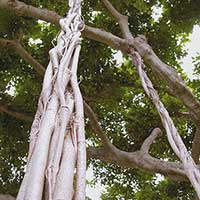 Close-up of a 30 foot tall, six year old section of aerial roots that are beginning to coalesce to form a solid trunk.
Close-up of a 30 foot tall, six year old section of aerial roots that are beginning to coalesce to form a solid trunk.


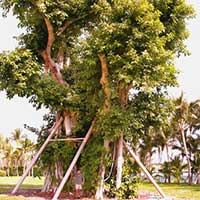
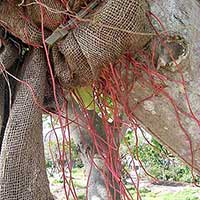
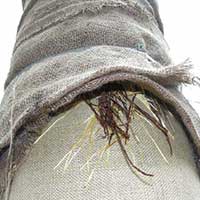
 About Hurricane & Typhoon Tree Recovery
About Hurricane & Typhoon Tree Recovery Ficus Species & Hurricane Horticulture
Ficus Species & Hurricane Horticulture Hurricane Tree and Palm Restoration
Hurricane Tree and Palm Restoration Saving Large Fallen Trees after Hurricane Andrew
Saving Large Fallen Trees after Hurricane Andrew